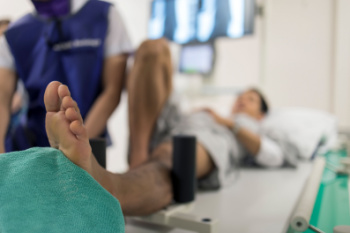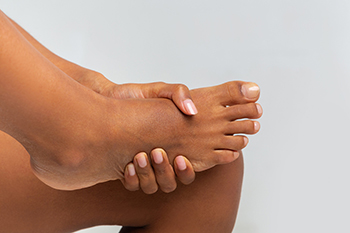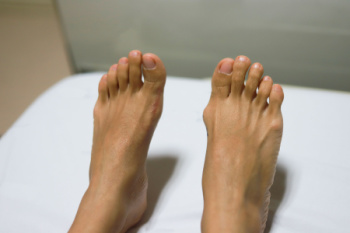
Healthcare workers require shoes that support their demanding roles, providing comfort and safety throughout long shifts. Key features include excellent cushioning to absorb shock and reduce fatigue, as these professionals often spend hours on their feet. Slip-resistant outsoles are vital for preventing slips and falls in environments where spills are common. Breathable materials help keep feet cool and dry, reducing the risk of discomfort and odor during long hours. Additionally, shoes with a secure fit and adequate arch support are essential for preventing foot pain and injuries. Easy-to-clean surfaces are also important, as healthcare environments require high hygiene standards. If you work in the healthcare profession and have sustained a foot injury, it is suggested that you consult a podiatrist who can treat various foot conditions and provide additional guidance on what type of shoes to wear.
While working on the feet, it is important to take the proper care of them. For more information about working on your feet, contact Bruce Smit, DPM from Frankfort Foot & Ankle Clinic. Our doctor will treat your foot and ankle needs.
Working on Your Feet
Standing on your feet for long periods of time can cause stress and pain in your feet. Your whole body may experience change in terms of posture, back pain, bunions, callouses and or plantar warts. There are ways to avoid these conditions with proper foot care, smart choices and correct posture.
Positive Changes
Negative heeled shoe – Choosing this shoe type places the heel slightly lower than the ball of the foot. These are great for overall foot health. Find shoes that fit you correctly.
Go barefoot – Our feet were not designed to be enclosed for all hours of the day. Try to periodically expose your feet to air.
Eliminate Pain
Foot Exercises – Performing simple exercises, incorporating yoga and doing stretches are beneficial. This will allow increased blood flow to the area and muscles of the foot.
Achilles tendon – Stretching the foot out flat on the floor will relax the calf muscles and tendon. These exercises can be performed almost anywhere. Make sure you add these exercises to your daily regimen.
With a little bit of this information and knowing more about foot health, you will notice changes. Foot stretches and proper footwear will help with pain and prevent further issues.
If you have any questions please feel free to contact our office located in Frankfort, IL . We offer the newest diagnostic and treatment technologies for all your foot and ankle needs.

A partial rupture of the Achilles tendon is a significant injury often seen in athletes and active individuals. This condition typically results from sudden, intense activity or repetitive strain on the tendon. Symptoms may include pain along the back of the heel, swelling, and difficulty walking or pushing off the foot. Patients often describe a sensation of tightness or discomfort during movement. To diagnose this injury, podiatrists frequently use Thompson's test, which assesses the integrity of the tendon. During this test, the patient lies face down and the doctor squeezes the calf muscle. If the foot does not move, it indicates a possible rupture. If you have endured an Achilles tendon injury, it is suggested that you promptly contact a podiatrist who can accurately diagnose and treat this condition.
Achilles tendon injuries need immediate attention to avoid future complications. If you have any concerns, contact Bruce Smit, DPM of Frankfort Foot & Ankle Clinic. Our doctor can provide the care you need to keep you pain-free and on your feet.
What Is the Achilles Tendon?
The Achilles tendon is a tendon that connects the lower leg muscles and calf to the heel of the foot. It is the strongest tendon in the human body and is essential for making movement possible. Because this tendon is such an integral part of the body, any injuries to it can create immense difficulties and should immediately be presented to a doctor.
What Are the Symptoms of an Achilles Tendon Injury?
There are various types of injuries that can affect the Achilles tendon. The two most common injuries are Achilles tendinitis and ruptures of the tendon.
Achilles Tendinitis Symptoms
Rupture Symptoms
Treatment and Prevention
Achilles tendon injuries are diagnosed by a thorough physical evaluation, which can include an MRI. Treatment involves rest, physical therapy, and in some cases, surgery. However, various preventative measures can be taken to avoid these injuries, such as:
If you have any questions please feel free to contact our office located in Frankfort, IL . We offer the newest diagnostic tools and technology to treat your foot and ankle needs.

Walking sticks can be an excellent tool for enhancing stability. They can reduce the risk of falls, particularly for people who have balance problems or for those who walk on uneven surfaces. The additional points of contact with the ground provided by walking sticks can help distribute body weight. This reduces strain on the feet and alleviates pressure that might otherwise lead to pain or even injury. Walking sticks also promote better posture, which reduces foot fatigue during prolonged walks or hikes. When used correctly, walking sticks can assist in maintaining balance and controlling foot movements, which helps minimize slips and trips. It is important to adjust the walking sticks to your height to ensure they provide adequate support for your walking style. A podiatrist can evaluate your specific needs and guide you on whether walking sticks are appropriate for your foot health. If you need an assistive device for walking, it is suggested that you schedule an appointment with a podiatrist who can determine if walking sticks are right for you.
Exercising your feet regularly with the proper foot wear is a great way to prevent injuries and build strength. If you have any concerns about your feet, contact Bruce Smit, DPM from Frankfort Foot & Ankle Clinic. Our doctor can provide the care you need to keep you pain-free and on your feet.
Exercise for Your Feet
Exercise for your feet can help you gain strength, mobility and flexibility in your feet. They say that strengthening your feet can be just as rewarding as strengthening another part of the body. Your feet are very important, and we often forget about them in our daily tasks. But it is because of our feet that are we able to get going and do what we need to. For those of us fortunate enough to not have any foot problems, it is an important gesture to take care of them to ensure good health in the long run.
Some foot health exercises can include ankle pumps, tip-toeing, toe rises, lifting off the floor doing reps and sets, and flexing the toes. It is best to speak with Our doctor to determine an appropriate regimen for your needs. Everyone’s needs and bodies are different, and the activities required to maintain strength in the feet vary from individual to individual.
Once you get into a routine of doing regular exercise, you may notice a difference in your feet and how strong they may become.
If you have any questions please feel free to contact our office located in Frankfort, IL . We offer the newest diagnostic and treatment technologies for all your foot and ankle needs.

Tendonitis and stress fractures are both foot issues that can lead to significant pain. Tendonitis is the inflammation of tendons, which are the tissues that connect muscles to bones. This inflammation often results in pain, swelling, and restricted movement in the affected area. Stress fractures are tiny cracks in the bones, typically occurring in the long bones of the foot, or metatarsals. Stress fractures result from repetitive pounding or overuse and are common among runners or other athletes. These fractures can cause sharp, localized pain, especially when placing weight on the affected foot. Differentiating between stress fractures and tendonitis is important because they call for different types of treatment. Tendonitis treatment is aimed at reducing inflammation, while stress fractures require rest and gradual healing. If you are experiencing foot pain that impedes your activities, it is suggested that you schedule an appointment with a podiatrist for a diagnosis and treatment.
Stress fractures occur when there is a tiny crack within a bone. To learn more, contact Bruce Smit, DPM from Frankfort Foot & Ankle Clinic. Our doctor can provide the care you need to keep you pain free and on your feet.
How Are They Caused?
Stress fractures are the result of repetitive force being placed on the bone. Since the lower leg and feet often carry most of the body’s weight, stress fractures are likely to occur in these areas. If you rush into a new exercise, you are more likely to develop a stress fracture since you are starting too much, too soon. Pain resulting from stress fractures may go unnoticed at first, however it may start to worsen over time.
Risk Factors
Stress fractures do not always heal properly, so it is important that you seek help from a podiatrist if you suspect you may have one. Ignoring your stress fracture may cause it to worsen, and you may develop chronic pain as well as additional fractures.
If you have any questions, please feel free to contact our office located in Frankfort, IL . We offer the newest diagnostic and treatment technologies for all your foot care needs.

Painful foot injuries can significantly impact daily life. One common issue is neuromas, painful nerve tumors typically occurring between the toes. Stress fractures, often caused by overuse or sudden increases in activity, result in tiny cracks in the foot bones and cause sharp pain. Plantar fasciitis involves inflammation of the band of tissue running along the bottom of the foot, leading to heel pain, that is noticeable in the morning. Heel spurs on the other hand are bony growths on the heel bone that can cause pain during movement. Foot pain can cause difficulty in completing daily activities. If you have pain in any area of your foot, it is strongly suggested that you schedule an appointment with a podiatrist who can offer appropriate treatment solutions.
Foot Pain
Foot pain can be extremely painful and debilitating. If you have a foot pain, consult with Bruce Smit, DPM from Frankfort Foot & Ankle Clinic. Our doctor will assess your condition and provide you with quality foot and ankle treatment.
Causes
Foot pain is a very broad condition that could be caused by one or more ailments. The most common include:
Diagnosis
To figure out the cause of foot pain, podiatrists utilize several different methods. This can range from simple visual inspections and sensation tests to X-rays and MRI scans. Prior medical history, family medical history, and any recent physical traumatic events will all be taken into consideration for a proper diagnosis.
Treatment
Treatment depends upon the cause of the foot pain. Whether it is resting, staying off the foot, or having surgery; podiatrists have a number of treatment options available for foot pain.
If you have any questions, please feel free to contact our office located in Frankfort, IL . We offer the newest diagnostic and treatment technologies for all your foot care needs.

Turf toe affects the metatarsophalangeal, or MTP, joint at the base of the big toe. It is typically caused by a sudden hyperextension of the toe, such as a push-off motion in certain sports, dance, or gymnastics. Turf toe often affects athletes who play on artificial turf, but it can also occur in non-athletic settings. Severity of the injury ranges from a mild stretch of the soft tissue to a complete tear, causing pain, swelling, and limited movement. A podiatrist can assess the extent of the MTP joint injury through a physical exam and, if necessary, imaging tests like X-rays or MRI scans. Treatment may include orthotics or even surgery to ensure proper healing and prevent long-term complications. If you are experiencing pain under the big toe, it is suggested that you schedule an appointment with a podiatrist for an exam, diagnosis, and treatment options.
Toe pain can disrupt your daily activities. If you have any concerns, contact Bruce Smit, DPM of Frankfort Foot & Ankle Clinic. Our doctor can provide the care you need to keep you pain-free and on your feet.
What Causes Toe Pain?
Most severe toe pain is caused due to a sports injury, trauma from dropping something heavy on the toe, or bumping into something rigid. Other problems can develop over time for various reasons.
Toe pain can be caused by one or more ailments. The most common include:
When to See a Podiatrist
Diagnosis
In many cases the cause of toe pain is obvious, but in others, a podiatrist may want to use more advanced methods to determine the problem. These can range from simple visual inspections and sensation tests to X-rays and MRI scans. Prior medical history, family medical history, and any recent physical traumatic events will all be taken into consideration for a proper diagnosis.
Treatment
Treatments for toe pain and injuries vary and may include shoe inserts, padding, taping, medicines, injections, and in some cases, surgery. If you believe that you have broken a toe, please see a podiatrist as soon as possible.
If you have any questions please feel free to contact our office located in Frankfort, IL . We offer the newest diagnostic tools and technology to treat your foot and ankle needs.

Ankle pain during and after running can stem from various causes. Overuse injuries are common, as repetitive stress on the ankle can lead to conditions like tendinitis or stress fractures. Wearing poor footwear or having inadequate support can worsen these issues, leading to discomfort. Additionally, improper running form or sudden changes in intensity can strain the ankle ligaments and muscles. Sometimes, underlying conditions like arthritis may contribute to persistent pain. Injuries like sprains or strains, often resulting from uneven surfaces or accidental twists, can also be a factor. Addressing these issues involves ensuring proper footwear, gradually increasing running intensity, and incorporating strength and flexibility exercises. If you have ankle pain from running, it is suggested that you visit a podiatrist who can offer you effective treatment methods.
Ankle pain can have many different causes and the pain may potentially be serious. If you have ankle pain, consult with Bruce Smit, DPM from Frankfort Foot & Ankle Clinic. Our doctor will assess your condition and provide you with quality foot and ankle treatment.
Ankle pain is any condition that causes pain in the ankle. Due to the fact that the ankle consists of tendons, muscles, bones, and ligaments, ankle pain can come from a number of different conditions.
Causes
The most common causes of ankle pain include:
Symptoms
Symptoms of ankle injury vary based upon the condition. Pain may include general pain and discomfort, swelling, aching, redness, bruising, burning or stabbing sensations, and/or loss of sensation.
Diagnosis
Due to the wide variety of potential causes of ankle pain, podiatrists will utilize a number of different methods to properly diagnose ankle pain. This can include asking for personal and family medical histories and of any recent injuries. Further diagnosis may include sensation tests, a physical examination, and potentially x-rays or other imaging tests.
Treatment
Just as the range of causes varies widely, so do treatments. Some more common treatments are rest, ice packs, keeping pressure off the foot, orthotics and braces, medication for inflammation and pain, and surgery.
If you have any questions, please feel free to contact our office located in Frankfort, IL . We offer the newest diagnostic and treatment technologies for all your foot care needs.

Early signs of bunion formation often begin subtly, with symptoms such as redness, swelling, and tenderness surronding the base of the big toe. As the bunion progresses, the big toe may start to lean toward the other toes, creating a visible bump on the side of the foot. Over time, you might also notice thickened skin or calluses developing due to the increased pressure on the affected area. Simple adjustments like avoiding wearing ill-fitting shoes and high heels, while opting for wide, comfortable, soft-soled shoes, can help to manage symptoms. A podiatrist may recommend placing spacers between the toes to prevent rubbing, covering the bunion with pads, and stretching calf muscles to improve joint alignment. This foot doctor also may prescribe orthotic devices to slow the progression of the bunion and improve your foot health. If you believe a bunion is forming on your toe, it is suggested that you schedule an appointment with a podiatrist for an evaluation and proactive treatment options.
If you are suffering from bunions, contact Bruce Smit, DPM of Frankfort Foot & Ankle Clinic. Our doctor can provide the care you need to keep you pain-free and on your feet.
What Is a Bunion?
A bunion is formed of swollen tissue or an enlargement of boney growth, usually located at the base joint of the toe that connects to the foot. The swelling occurs due to the bones in the big toe shifting inward, which impacts the other toes of the foot. This causes the area around the base of the big toe to become inflamed and painful.
Why Do Bunions Form?
Genetics – Susceptibility to bunions are often hereditary
Stress on the feet – Poorly fitted and uncomfortable footwear that places stress on feet, such as heels, can worsen existing bunions
How Are Bunions Diagnosed?
Doctors often perform two tests – blood tests and x-rays – when trying to diagnose bunions, especially in the early stages of development. Blood tests help determine if the foot pain is being caused by something else, such as arthritis, while x-rays provide a clear picture of your bone structure to your doctor.
How Are Bunions Treated?
If you have any questions, please feel free to contact our office located in Frankfort, IL . We offer the newest diagnostic and treatment technologies for all your foot care needs.